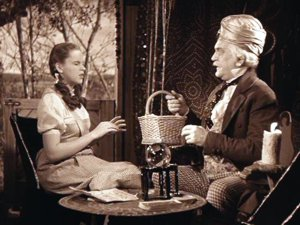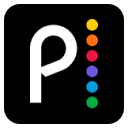In the opening scenes of The Wizard of Oz, Dorothy runs away from her Kansas home and promptly encounters Professor Marvel, a seedy, itinerant con artist whose tacky traveling wagon advertises him as "Acclaimed by The Crown Heads of Europe," and offers his services to "Read Your Past, Present, and Future in His Crystal Ball."
Professor Marvel, played marvelously by Frank Morgan, takes one look at the naive girl, glances down at her suitcase and says, "You're running away!"
Having missed his glance, Dorothy asks wondrously, "How did you guess?"
The Professor replies, "Now, why are you running away? No, no, don't tell me!" He looks off pensively, as if conjuring some magical power and then, as if having divined a vision, says conclusively, "They don't understand you at home!"
The wide-eyed girl smiles and says, "Why it's just like you could read what was inside me!"

The Professor then offers Dorothy a crystal ball reading and asks her to close her eyes and concentrate. As she does, the Professor quickly rummages around in her basket. He then proceeds to describe what he pretends to see in the crystal ball, referencing the items in the basket.
Clearly, Professor Marvel is a charlatan, but there is a positive lesson to be learned from his trickery. He was able to connect with Dorothy and establish her trust by referencing relevant facts about her. The lesson here is that presenters can connect with their audiences by making references to relevant facts about individuals in the audience or about the audience as an affinity group.
Such connections are rare in today's presentations. Most presenters, pressed by the demands of business, pirate their colleagues' slides, do minimal preparation, and then dump a load of generic data on their audiences who, to all intents and purposes, would have been better off accessing a canned webinar.
Finding relevant facts that can customize any presentation doesn't require manipulative glances, the covert services of a private investigator, or an army of academic researchers. There are seven simple techniques anyone can use to build powerful connections with any audience.
1. Direct References. Schmooze. Just before your presentation, mingle with your audience. Chat with several different individuals. Talk with strangers as well as people you know. Ask them questions. Listen to their conversations. Gather information as well as names and data points. Then when you step up to the front of the room, weave the names and information you've collected into your presentation.
2. Mutual References. Before your presentation, learn as much as you can about your audience. Visit their home pages. Cross-reference with web search. Find links to persons, companies, or organizations that are in some way related to both you and your audience. Then, at appropriate moments during your presentation, speak about those connections. Think of this as a tasteful, appropriate form of name-dropping.
3. Ask Questions. During your presentation, ask your audience questions; seek their opinions rather than answers to factual or true/false questions. Invite them to share their ideas, reactions, or stories.
4. Contemporize. On the day of your presentation, scour the web, read the newspapers, listen to the radio or watch television and find events or items that are relevant to your subject and your audience.
5. Localize. Prepare specific references to the venue of your presentation. Some informationbout a locale is common knowledge; some is available on the web. In addition, a new website called Newseum provides access to the front pages of local daily newspapers around the country and the world by city. Make your presentations fresh with up-to-the-minute references.
6. Data. Find specific information that links to and supports your message. The more closely linked your data is to your audience, the better. If the information you cite is new to your audience, they will be impressed by the depth and currency of your knowledge. If your audience is already aware of the data, they will be pleased that you made the effort to relate to them.
7. Customize your first slide. Begin your presentation with a slide that includes the location, the date, and the logo of your audience or event.
You don't have be a Professor Marvel, but you can have your audience marvel at your efforts to connect and personalize.
Related
Sign up for Peacock to stream NBCU shows.
to stream NBCU shows.